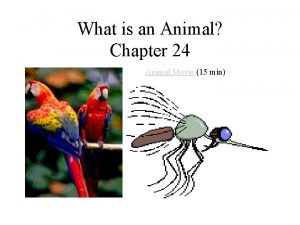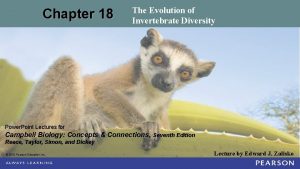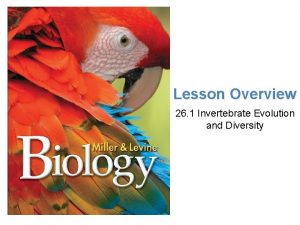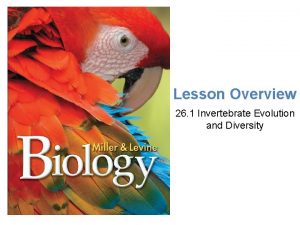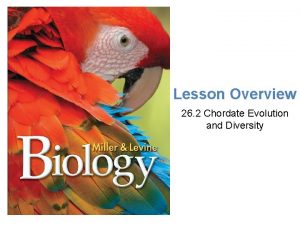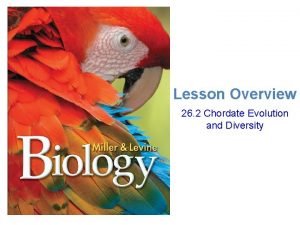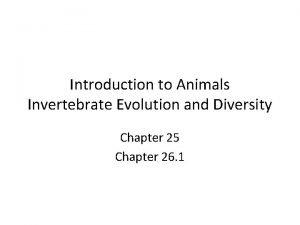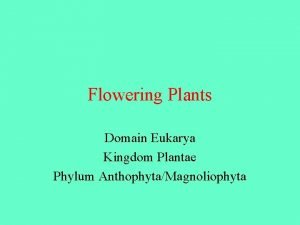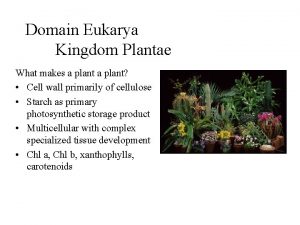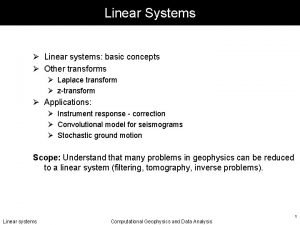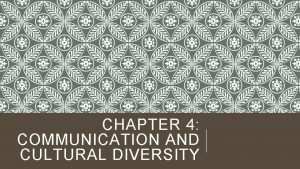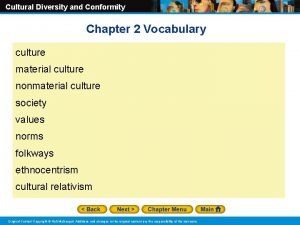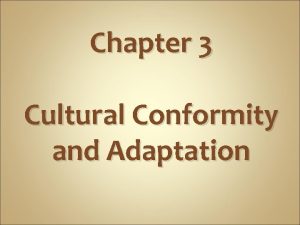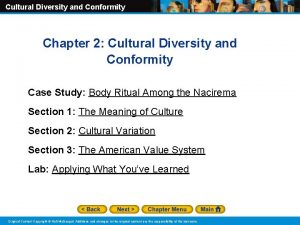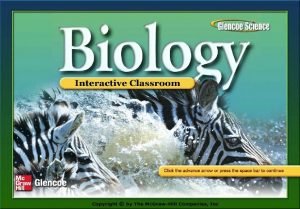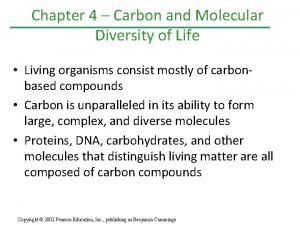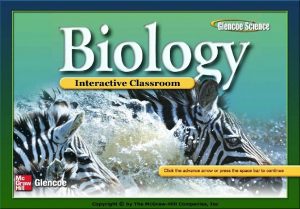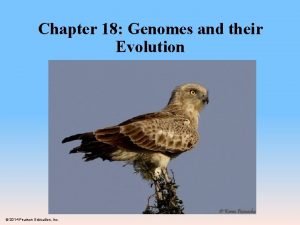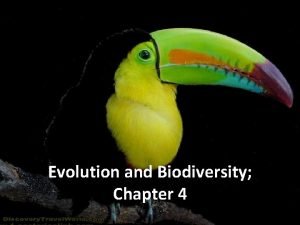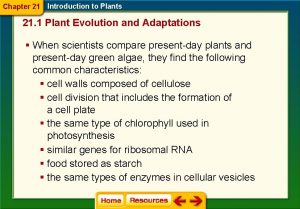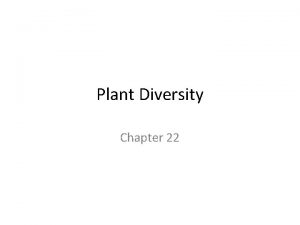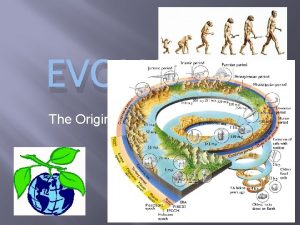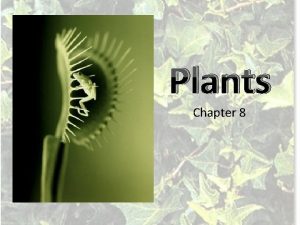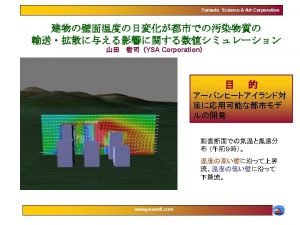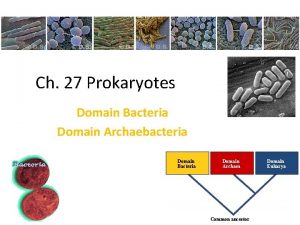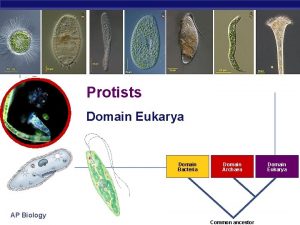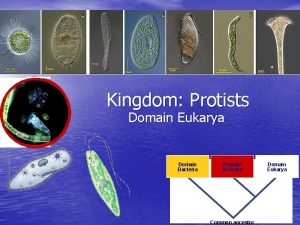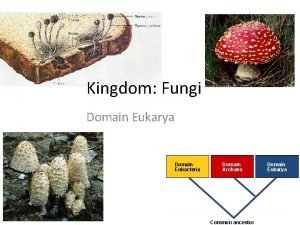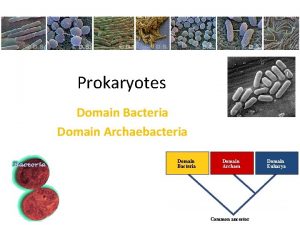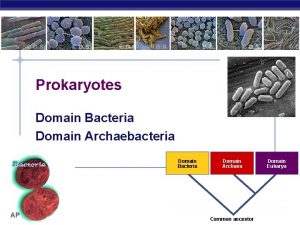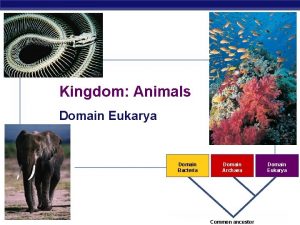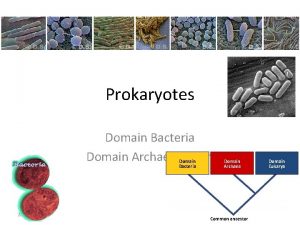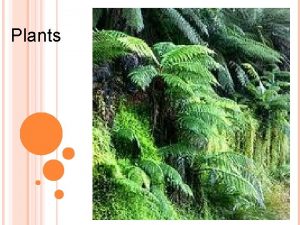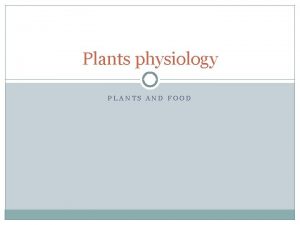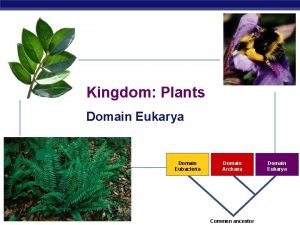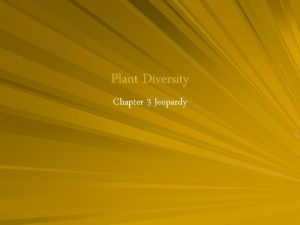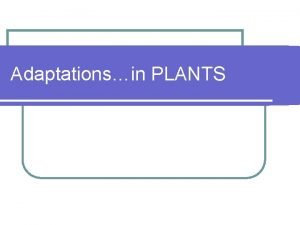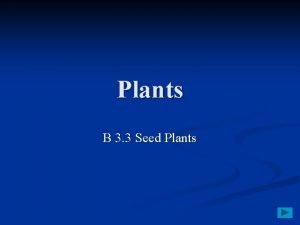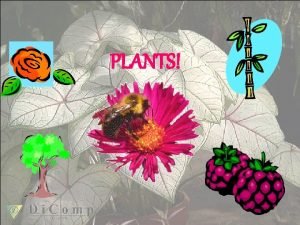Chapter 24 Evolution and Diversity of Plants Domain


















































- Slides: 50

Chapter 24 - Evolution and Diversity of Plants Domain – Eukarya Kingdom - Plantae

Plant Kingdom n n n Plants are multicellular, Primarily terrestrial eukaryotes Autotrophic by photosynthesis Approximately 265, 000 different types of plants exist today. Plants began the transition to land about 425 million years ago. Plants play a critical role as producers in the world's food webs; using photosynthesis to produce organic biomass and releasing oxygen as an end-product.

Plant Kingdom n n n Terrestrial plants carry on gas exchange through pores (stomata) on the surface of leaves. Oxygen and water vapor leave thru stomata, and carbon dioxide enters through the stomata. (note: stoma (singular)) The leaves are covered with a waxy cuticle to prevent desiccation.

Plant Kingdom n Plant chloroplasts contain chlorophyll a, chlorophyll b, and a variety of yellow and orange carotenoids. n Plant cell walls are composed of cellulose. n Plants store carbohydrate as starch.

Plant reproduction n Nearly all plants reproduce sexually, though many also are capable of asexual modes of reproduction. q n n Alternation of generations occurs in the life cycle of plants, with a haploid, gamete-producing gametophyte stage alternating with a diploid, spore-producing sporophyte stage. Bryophytes (true mosses) have a large, obvious gametophyte stage, but in other plants the sporophyte stage is larger and the gametophyte stage has been reduced.

Alternation of generations

Plant Evolution - marked by four major adaptations: n n (1) about 400 million years ago - the feature of a protected embryo; also spore production as a means of reproduction; (2) the evolution of vascular tissue; (3) the origin of seed producing plants about 360 million years ago; and (4) the evolution of flowering plants about 130 million years ago.

Plant Evolution

Nonvascular plants – e. g. mosses

Seedless vascular – e. g. ferns

Gymnosperms – seed cones

Angiosperms – seed flowering

Plants - Basic Vocabulary n vascular tissue - plant tissues that consist of cells that transport water and nutrients throughout the plant body. The two major types are xylem and phloem. q q xylem - vascular tissue that carries water and minerals from the roots to the rest of the plant. phloem - vascular tissue that carries sugar and organic nutrients (sap) throughout the plant. n gametangium - the gametophyte stage of mosses consisting of a male antheridium (sperm) and a female archegonium (egg) n gametophyte - multicellular, haploid stage of the life cycle that produces haploid gametes that fuse to form the diploid sporophyte - multicellular, diploid stage of the life cycle that through meiosis produces haploid gametes that become the gametophyte n

Vascular tissue qxylem - vascular tissue that carries water and minerals from the roots to the rest of the plant. qphloem - vascular tissue that carries sugar and organic nutrients (sap) throughout the plant.

Plant Kingdom: The Classification of Plants (Four major groups exist): Bryophytes (mosses) and Relatives Pteridophyta (Ferns) and Relatives Gymnosperms and Relatives Angiosperms and Relatives Examples Mosses, liverworts, hornworts Ferns, Psilotum (whisk fern), Lycopodium, Equisetum (horsetails) Conifers, Gingko, cycads Flowering plants, grasses, hardwoods Vascular tissue (xylem and phloem) Nonvascular Vascular Sporophyte/ Gametophyte (N) dominant Sporophyte dominant, small separate Gametophyte Sporophyte dominant Reproduction (spores or seeds) Spores Seeds Reproduction (Fertilization) Water Wind (Pollination) Wind/ animals (Flowers) Reproduction (Seed/spore dispersal) Water/ Wind Spores Wind Seeds Wind/ animals (Fruits) Seeds

Reduction in size of the gametophyte

Nonvascular Plants Mosses and Relatives – bryophytes No true roots (rhizoids), stems, or leaves Gametophyte stage dominant, no vascular tissue, spores as a means of reproduction q q q Phylum Bryophyta - (true mosses) (10, 000 species) Phylum Hepatophyta (liverworts) (6500 species) Phylum Anthocerophyta (hornworts) (100 species)

1. Bryophytes and their relatives n n n Phylum Bryophyta (mosses) - lack vascular tissue but have certain adaptations that made a terrestrial existence possible including having a waxy cuticle, and female gametes that develop and are fertilized within a protective gametangia. The male gametangium is the antheridium and the female gametangium is the archegonium. The egg is fertilized within the archegonium and the sporophyte stage grows out of the body of the gametophyte stage. Because mosses lack vascular tissue they must absorb water by diffusion and capillary action which limits them to shady, moist habitats and a relatively small body size. 1. antheridium 2. archegonium 3. sporophyte 4. gametophyte

Moss life cycle

Bryophytes and their relatives, contd. n n * Phylum Hepatophyta (liverworts) diminutive plants with lobed bodies ("lobed herbs"), liverworts have a life cycle similar to mosses. They can also reproduce asexually by gemmae (groups of cells) which are dispersed when raindrops fall into their protective cups. * Phylum Antherocerophyta (hornworts) resemble liverworts but have horn-shaped sporophyte stage

Vascular Plants – Seedless n n n sporophyte stage dominant; small gametophyte present; vascular tissue present; spores as a means of reproduction Phylum Psilophyta (whiskferns) (13 species) Phylum Lycophyta (club mosses) (1, 000 species) Phylum Sphenophyta (horsetails) (15 species) Phylum Pterophyta (ferns) (12, 000 species)

2. Ferns and their relatives: n Phylum Psilophyta (whiskferns) - Psilotum, lacks true roots and leaves, have rhizomes which are underground stems covered with rhizoid hairs. The body plan of the whiskferns probably is similar to the earliest vascular plants.

Ferns and their relatives, contd. n Phylum Lycophyta (lycopods, club mosses, ground pines) - Lycopodium and Sellaginella, the sporangia of Lycopodium are borne on sporophylls, leaves specialized for reproduction. Gametophyte stage is inconspicuous and develops underground. Heterosporous, the megaspores develop into female gametophytes bearing archegonia and the microspores develop into male gametophytes bearing antheridia.

Ferns and their relatives, contd. n Phylum Sphenophyta (horsetails): Equisetum, conspicuous sporophyte, silica in the epidermal cells give these plants a glassy texture. Equisetum was also formerly called "scouring rush" because the glassy texture made them useful for scrubbing pots and pans. Gametophyte stage is small but photosynthetic and free-living.

Ferns and their relatives, contd. n n Phylum Pterophyta (ferns): large sporophyte stage, ferns are widely distributed in the tropics and relatively common in temperate regions. Some of the leaves (fronds) of ferns are specialized sporophylls with clusters of spores called sori on the underside of the frond. The airborne spores are catapulted from the sorus. frond – leaves of ferns sorus – on underside of leaves/ hold spores rhizome – branching underground stem w/ rootlike hairs

Fern life cycle

Vascular Plants - Seed Producers n – sporophyte stage dominant; vascular tissue, seeds as a means of reproduction n 3. Gymnosperms Division Coniferophyta (550 species) Division Cycadophyta (100 species) Division Ginkgophyta (1 species) Division Gnetophyta (70 species) n n (conifers) (cycads) (ginkgo) (gnetae)

3. Gymnosperms and their relatives: n Phylum Coniferophyta (pines, spruce, firs, larches, n n cedars, cypresses, redwoods): produce a cone which supports and protects the seed. Most conifers are evergreen and their needleshaped leaves adapt them to dry habitats. Important source of most of our lumber and pulp paper. The bristlecone pine is one of the oldest organisms (4600 years old), while the redwoods are the largest organisms alive (the "General Sherman" tree has a trunk circumference of 26 m.

Phylum Coniferophyta, contd. n In the life cycle of the pine, the sporophyte generation would be represented by the pine tree itself, while the gametophyte generation has been reduced to female (ovulate) and male (pistillate) cones. These plants produce true seeds which consist of a developing embryo, a nutrient supply, and a protective seed coat. Conifers are monoecious since trees produce both pollen and seed cones.

Phylum Coniferophyta life cycle of the pine

Pollen grains

4. Angiosperms n n n sporophyte dominant, vasculat plants, seeds, fruits and flowers Phylum Anthophyta (flowering plants) (240, 000 species) The angiosperms are extremely important providing all of our fruits and vegetables, and providing medicines, fiber, perfumes, and decorations.

4. Angiosperms and their relatives n Angiosperms (flowering plants) - the dominant form of plant life on earth at the present time; 240, 000 species. q monocots Monocotyledons q dicots Dicotyledons

monocots Monocotyledons q q Consists of monocots (lilies, orchids, yuccas, palms, pineapples, grasses, and cereal grains) which have flower parts in threes or multiples of three (3); and one cotyledon (seed leaf) in their seeds

Monocot flower, a daylily

dicots Dicotyledons q q dicots (oak, hickory, asters, roses, maples, strawberries, cactuses, beans) which have flower parts in four or fives, or multiples of four (4) or five (5), and two cotyledons (seed leaf) in their seeds

Dicot flower, an azalea

Angiosperm characteristics n n Have well-developed and efficient vascular tissue including xylem (tracheids and vessels) and phloem (sieve tubes and companion cells). Four major flower parts may be present: the calyx consisting of sepals that protect the flower; the corolla consisting of petals to attract pollinators; the stamens (male pollen-producing structure consisting of and anther and filament); and the carpel (pistil) (female egg-producing structures consisting of the stigma, style, and ovary).

General Flower Structure Angiosperms male pollen-producing structure pistil female egg-producing structures

Flower diversity – monocots and dicots

Angiosperm Vocabulary n n n ovule - holds the megasporangium and female gametophyte which produces an egg; the ovule later becomes the seed ovary - the enlarged base of the pistil, which forms the fruit - a ripened, thickened ovary of a flower, which protects the seeds and assists their dispersal pollination - transfer of pollen from microsporangium to female gametophyte fertilization - fusion of sperm nucleus with egg nucleus

Flowering plant life cycle Angiosperm

Four Trends in Angiosperm Evolution n n 1. Number of floral parts has been reduced 2. Floral parts have become fused 3. Symmetry has changed from radial to bilateral 4. Ovary has dropped to a position below the petals and sepals (inferior) where the flowers are better protected * Flowering plants and land animals have co-evolved to develop many different types of relationships related to pollination and reproduction.

Plant uses and benefits

Plant uses and benefits

Plant uses and benefits

Plant uses and benefits

Plant uses and benefits

Plant uses and benefits

Plant uses and benefits
 Tiburonia granrojo
Tiburonia granrojo Chapter 18 the evolution of invertebrate diversity
Chapter 18 the evolution of invertebrate diversity Lesson 4 invertebrate evolution and diversity 1
Lesson 4 invertebrate evolution and diversity 1 Invertebrate evolution and diversity 2 practice
Invertebrate evolution and diversity 2 practice Chordate cladogram
Chordate cladogram Fish tail bird
Fish tail bird Invertebrate evolution and diversity 2
Invertebrate evolution and diversity 2 Why is genetic diversity important
Why is genetic diversity important Genetic diversity vs species diversity
Genetic diversity vs species diversity Classify flowering and nonflowering plants
Classify flowering and nonflowering plants Diversity of learning domain
Diversity of learning domain Codomain vs range
Codomain vs range Frequency domain to time domain
Frequency domain to time domain What are language processing activities
What are language processing activities Vascular plants
Vascular plants Non vascular plants
Non vascular plants C3 plants vs c4 plants
C3 plants vs c4 plants Eukarya plantae
Eukarya plantae What domain is plantae in
What domain is plantae in Z domain to frequency domain
Z domain to frequency domain Time reversal z transform
Time reversal z transform Z transform of ramp function
Z transform of ramp function Domain specific vs domain general
Domain specific vs domain general Domain specific vs domain general
Domain specific vs domain general Problem domain vs knowledge domain
Problem domain vs knowledge domain S domain to z domain
S domain to z domain Chapter 5 diversity and human needs and development
Chapter 5 diversity and human needs and development Chapter 8 human resources culture and diversity
Chapter 8 human resources culture and diversity Chapter 8 human resources culture and diversity
Chapter 8 human resources culture and diversity Biological diversity and conservation chapter 5 answers
Biological diversity and conservation chapter 5 answers Chapter 4 communication and cultural diversity
Chapter 4 communication and cultural diversity Cultural diversity and conformity section 3
Cultural diversity and conformity section 3 Cultural diversity and conformity chapter test form a
Cultural diversity and conformity chapter test form a Examples of countercultures
Examples of countercultures Chapter 4 growth diversity and conflict
Chapter 4 growth diversity and conflict Chapter 4 growth diversity and conflict
Chapter 4 growth diversity and conflict Culturological assessment
Culturological assessment Government chapter 21 diversity and discrimination
Government chapter 21 diversity and discrimination Chapter 4 communication and cultural diversity
Chapter 4 communication and cultural diversity Chapter 13 diversity and difference in health care
Chapter 13 diversity and difference in health care Chapter 5 section 1 biodiversity
Chapter 5 section 1 biodiversity Chapter 4 carbon and the molecular diversity of life
Chapter 4 carbon and the molecular diversity of life Chapter 5 evolution and community ecology answer key
Chapter 5 evolution and community ecology answer key Chapter 21 section 1 plant evolution and adaptations
Chapter 21 section 1 plant evolution and adaptations Chapter 18 genomes and their evolution
Chapter 18 genomes and their evolution Chapter 5 evolution and community ecology
Chapter 5 evolution and community ecology Chapter 5 evolution and community ecology
Chapter 5 evolution and community ecology Chapter 4 biodiversity and evolution
Chapter 4 biodiversity and evolution Anthocerophytes
Anthocerophytes Chapter 14 evolution a history and a process
Chapter 14 evolution a history and a process Reproduction in bryophytes ppt
Reproduction in bryophytes ppt
